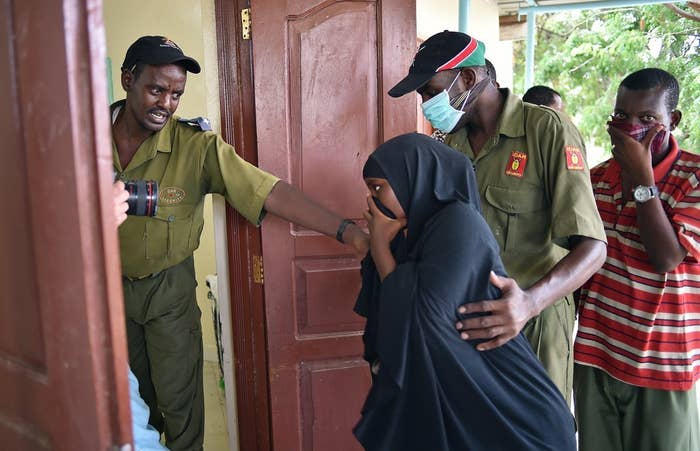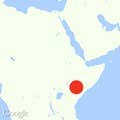
GARISSA, Kenya — For hours this morning, the local hospital was empty.
The bodies of the students killed at Garissa University, in Kenya's most deadly terrorist attack in nearly 10 years, had all been flown to Nairobi. The survivors had been nursed to health, or nursed well enough to make their way home. And with the emergency largely over, the non-local staff had left, too.
At least 70 of doctors and nurses, who aren't from Garissa, had felt too unsafe, and too exhausted, to continue, a hospital administrator who was not authorized to speak publicly said.
"They've really done more than any one person can stand," he said. "You can't blame them for leaving the job."
Officials say 147 people were killed when gunmen from al-Shabaab, the Somali terror group, stormed Garissa University.
Like many students on campus, most public servants — especially teachers and medical workers — come from elsewhere to work in Garissa, a steamy outpost that is the last real town in Kenya before the Somali border.
The administrator said local volunteers had stepped up to help keep the hospital running. But at 10 a.m. Saturday, the non-emergency medical wards were empty of staff. A man stabbed in a cell phone robbery last night lay untended on a bed without sheets. He said he hadn't seen any medical staff since someone replaced his IV drip, already empty again.
The hospital was still waiting waited to receive more survivors of Thursday's attack. One woman was brought in rescued from her hiding place on the roof of a hostel, where students live. She told BuzzFeed News she had covered herself with laundry to avoid the attackers. She had been brought to the hospital for a checkup and trauma counseling.
About an hour later, an ambulance was dispatched for a half-dozen other survivors, said by another hospital staffer to have hidden in the rafters of their rooms. Two more survivors, the hospital administrator was overhead saying on his phone, "were brought out of the water tank...and they are saying there are more in the ceilings."
Local residents flocked to the hospital grounds. They had heard that the bodies of the attackers killed Thursday were going to be publicly displayed, and people wanted to see them. Roughly 100 people gathered behind yellow police tape, staring at the tiny morgue and waiting for hours in the merciless sun.
"So many times the government has said they have killed terrorists," said Abdi Mohamed, "but we have not seen it."
Last year, in late November, al-Shabaab hijacked a bus full of teachers on their way home from their posting in nearby Mandera, separating the passengers by religion and executing the Christians. Days later, Kenya's Deputy President William Ruto claimed the government had killed 100 terrorists in Mogadishu. Skepticism quickly surfaced on social media.
^ I doubt this. .. @robjillo: Capital Mobile » KDF killed 100 Shabaab after Mandera massacre – Ruto http://t.co/TE1xCQ7Rj3
So the KDF say they killed 100 Al Shabaab. SHOW ME THE RECEIPTS. #MySecurityMyRight
Many Kenyans still doubt the government's assurances that it has killed the al-Shabaab members who attacked the Westgate mall in 2013, killing 68.
A county official said the interior ministry had decided to display the bodies of the attackers in the Garissa assault, which had arrived at the morgue only this morning and were bloated and rotting from decay and the intense heat, to head off just that kind of doubt.
"It's giving them the benefit of the doubt that we've neutralized these people. We've killed them," Yusuf Ali Korow, the press officer for Garissa County, told BuzzFeed News. "It's removing any doubt… that these people have escaped."
But others in the crowd had simple revenge in mind.
"We want to burn them," one man who had pushed to the front of the group said.
The display also stoked an open question, one asked daily here: Were the attackers Kenyan, or were they Somali? It's a pointed question in a country where collective blame falls on the shoulders of Kenya-born citizens with Somali heritage. Last year, the government rounded up anyone suspect of being Somali and carrying fraudulent paperwork, holding hundreds of them in the sports stadium in Nairobi.
Today, in response to the attack, police profiled residents in Eastleigh, a heavily Somali neighborhood in Nairobi.
Heavy presence of police in Eastleigh harrasing residents to produce Alshabaab @WanjeriNderu @InsecurityKE via @MagetoElijah1
Check point in Juuja-Road Eastleigh screening of buses from nothern kenya. why all this 2 only somalis.
This police spokesman on #checkPoint is in deep pain justifying the operation in Eastleigh
But the relationship between the attackers and the residents of Eastleigh, or other Somalis or Kenyans of Somali heritage living in the country, is still unclear.
"Those are not the faces of Somalis. Even the hair," said the hospital administrator, who had seen the bodies of the terrorists in the morgue earlier this morning. "Those are not Somalis."

